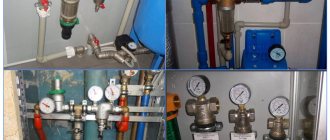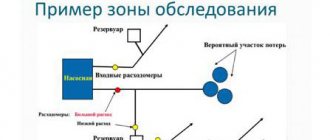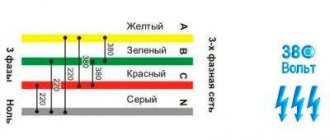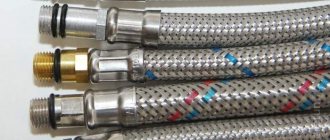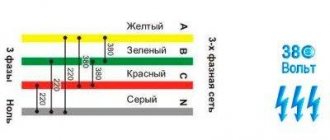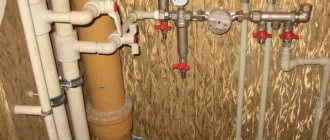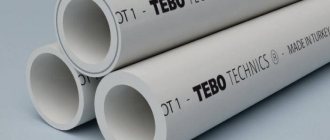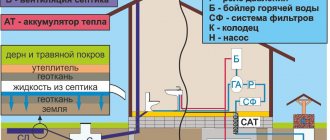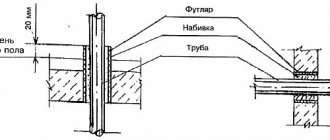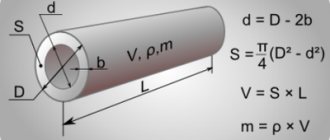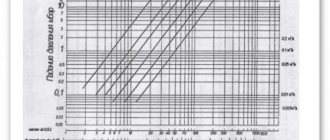The temperature of the coolant in the heating system depends on the air temperature outside, it is maintained according to the temperature schedule developed by specialists for each heat supply source differently, it all depends on local weather conditions. These schedules are developed so that even at very low air temperatures outside, a comfortable temperature for people is maintained in homes, about 20-22 ° C.
Temperature standards
Requirements for coolant temperature are set out in regulatory documents that establish the design, installation and use of engineering systems of residential and public buildings. They are described in the State Building Codes and Rules:
- DBN (V. 2.5-39 Heat networks);
- SNiP 2.04.05 “Heating, ventilation and air conditioning.”
For the calculated supply water temperature, the figure is taken that is equal to the water temperature at the outlet of the boiler, according to its passport data.
For individual heating, deciding what the coolant temperature should be should take into account the following factors:
- 1 Beginning and ending of the heating season based on the average daily outdoor temperature of +8 °C for 3 days;
- 2 The average temperature inside heated premises of housing, communal and public importance should be 20 °C, and for industrial buildings 16 °C;
- 3 The average design temperature must comply with the requirements of DBN V.2.2-10, DBN V.2.2.-4, DSanPiN 5.5.2.008, SP No. 3231-85.
According to SNiP 2.04.05 “Heating, ventilation and air conditioning” (clause 3.20), the coolant limit values are as follows:
- 1 For a hospital – 85 °C (excluding psychiatric and drug departments, as well as administrative or household premises);
- 2 For residential, public, and domestic buildings (not counting halls for sports, trade, spectators and passengers) – 90 °C;
- 3 For auditoriums, restaurants and premises for production of categories A and B – 105 °C;
- 4 For catering establishments (excluding restaurants) – this is 115 °C;
- 5 For production premises (categories B, D and D), where flammable dust and aerosols are emitted – 130 °C;
- 6 For staircases, lobbies, pedestrian crossings, technical premises, residential buildings, production premises without the presence of flammable dust and aerosols – 150 °C.
Depending on external factors, the water temperature in the heating system can be from 30 to 90 °C. When heated above 90 °C, dust and paintwork begin to decompose. For these reasons, sanitary standards prohibit greater heating.
To calculate optimal indicators, special graphs and tables can be used, which define standards depending on the season:
- With an average reading outside the window of 0 °C, the supply for radiators with different wiring is set at 40 to 45 °C, and the return temperature at 35 to 38 °C;
- At -20 °C, the supply is heated from 67 to 77 °C, and the return rate should be from 53 to 55 °C;
- At -40 °C outside the window, all heating devices are set to the maximum permissible values. On the supply side it is from 95 to 105 °C, and on the return side it is 70 °C.
What to do if the temperature of the radiators seems too low?
Call the plumbers. In many cases, the efficiency of the system is reduced due to disruption of coolant circulation. The reasons may be the following:
- Installation errors: incorrect choice of radiators themselves, fittings, pipes.
- The presence of an air lock that does not allow the coolant to fill the system.
- Overgrowing of the internal lumen of radiators, formation of lime deposits, corrosion.
If the plumbers have not found obvious reasons, it is worth starting proceedings with the utility supplier and measuring the temperature of the coolant. If the value is below the norm, a recalculation of the heating fee will be required.
Heating standards for apartment buildings heated centrally
These norms are the most “ancient”. They were calculated at a time when they did not save on fuel for heating the coolant, the batteries were hot. But houses were built mainly from materials that were “cold” in terms of heat-saving qualities, that is, from concrete panels.
Times have changed, but the norms remain the same. According to the current GOST R 52617-2000, the air temperature in residential premises should not be lower than 18°C (for corner rooms - at least 20°C). At the same time, the organization that supplies thermal energy has the right to reduce the air temperature at night (0-5 hours) by no more than 3°C. Heating standards are set separately for different rooms of the apartment: for example, in the bathroom it should be at least 25°C, and in the corridor - at least 16°C.
Society has been fighting for a long time, and at times not unsuccessfully, to change the procedure for determining heating standards, tying them not to the air temperature in the premises, but to the average temperature of the coolant. This indicator is much more objective for consumers, although it is unprofitable for the heat energy supplier. Judge for yourself: the temperature in residential premises often depends not only on the operating system, but on the nature of a person’s life activity and living conditions.
For example, the thermal conductivity of brick is much lower than that of concrete, so in a brick house at the same temperature you will have to spend less thermal energy. In rooms such as the kitchen, the process of cooking food does not generate much less heat than from radiators.
Much also depends on the design features of the heating devices themselves. For example, panel heating systems will have a higher heat transfer rate than cast iron radiators at the same air temperature. Thus, heating standards tied to air temperature are not entirely fair. This method takes into account the outside air temperature below 8°C. If such a value is recorded for three days in a row, the heat generating organization must unconditionally supply heat to consumers.
For the middle zone, the calculated values of the coolant temperature depending on the external air temperature have the following values (for the convenience of using these values using household thermometers, temperature indicators are rounded):
Outside air temperature, °C
Temperature of network water in the supply pipeline, °C
Using the table above, you can easily determine the water temperature in a panel heating system (or any other) by using a regular thermometer at the time of draining part of the coolant from the system. For the forward branch, use the data in columns 5 and 6, and for the return branch, use the data in column 7. Note that the first three columns establish the release temperature of the water, that is, without taking into account losses in the transmission main pipelines.
If the actual coolant temperature does not correspond to the standard temperature, this is the basis for a proportional reduction in the payment for the central heating services provided.
There is also an option to install heat meters, but it only works when all apartments in the building are served by a centralized heating system. In addition, such meters are subject to annual mandatory inspection.
Ways to reduce heat loss
The above information will help to be used to correctly calculate the coolant temperature norm and tell you how to determine situations when you need to use a regulator.
But it is important to remember that the temperature in the room is affected not only by the temperature of the coolant, street air and wind strength. The degree of insulation of the facade, doors and windows in the house should also be taken into account.
To reduce heat loss from your home, you need to worry about its maximum thermal insulation. Insulated walls, sealed doors, and metal-plastic windows will help reduce heat loss. This will also reduce heating costs.
Antifreeze as a coolant
This type of coolant, such as antifreeze, has higher characteristics for efficient operation of the heating system. By pouring antifreeze into the heating system circuit, you can reduce the risk of the heating system freezing during the cold season to a minimum. Antifreeze is designed for lower temperatures than water, and they are not able to change its physical condition. Antifreeze has many advantages, since it does not cause scale deposits and does not contribute to corrosive wear of the internal area of the heating system elements.
Even if antifreeze hardens at very low temperatures, it will not expand like water, and this will not cause any damage to heating system components. If it freezes, the antifreeze will turn into a gel-like composition, and the volume will remain the same. If, after freezing, the temperature of the coolant in the heating system increases, it will go from a gel-like state to a liquid state, and this will not cause any negative consequences for the heating circuit.
Many manufacturers add various additives to antifreeze that can increase the service life of the heating system.
Such additives help remove various deposits and scale from heating system elements, and also eliminate pockets of corrosion. When choosing antifreeze, you need to remember that such a coolant is not universal. The additives it contains are only suitable for certain materials.
Existing coolants for heating systems-antifreeze can be divided into two categories based on their freezing point. Some are designed for temperatures down to -6 degrees, and others up to -35 degrees.
Properties of various types of antifreeze
The composition of a coolant such as antifreeze is designed for a full five years of operation, or 10 heating seasons. The calculation of the coolant in the heating system must be accurate.
Antifreeze also has its disadvantages:
- The heat capacity of antifreeze is 15% lower than that of water, which means they will release heat more slowly;
- They have a fairly high viscosity, which means that a fairly powerful circulation pump will need to be installed in the system.
- When heated, antifreeze increases in volume more than water, which means that the heating system must include a closed expansion tank, and radiators must have a larger capacity than those used to organize a heating system in which water is the coolant.
- The speed of the coolant in the heating system - that is, the fluidity of antifreeze is 50% greater than that of water, which means that all connecting connectors of the heating system must be very carefully sealed.
- Antifreeze, which includes ethylene glycol, is toxic to humans, so it can only be used for single-circuit boilers.
When using a type of coolant such as antifreeze in a heating system, certain conditions must be taken into account:
- The system must be supplemented with a circulation pump with powerful parameters. If the circulation of coolant in the heating system and the heating circuit is long, then the circulation pump must be installed externally.
- The volume of the expansion tank must be no less than twice that of the tank used for a coolant such as water.
- It is necessary to install volumetric radiators and pipes with a large diameter in the heating system.
- It is prohibited to use automatic type air vents. For a heating system in which antifreeze is the coolant, only manual taps can be used. A more popular manual type crane is the Mayevsky crane.
- If antifreeze is diluted, then only with distilled water. Melt, rain or well water will not work.
- Before filling the heating system with coolant - antifreeze, it must be thoroughly rinsed with water, not forgetting about the boiler. Manufacturers of antifreeze recommend changing them in the heating system at least once every three years.
- If the boiler is cold, it is not recommended to immediately set high coolant temperature standards for the heating system. It should rise gradually, the coolant needs some time to heat up.
If in winter a double-circuit boiler running on antifreeze is turned off for a long period, then it is necessary to drain the water from the hot water supply circuit. If water freezes, it can expand and cause damage to pipes or other heating system components.
Types of polypropylene pipes
Polypropylene pipes are divided into two main types: reinforced or unreinforced . They are also divided according to their layout and material of manufacture. If the product has a blue stripe, then it is recommended for cold water supply, and a red one for hot water supply.
Products made of polypropylene of any type are marked with the letters PN. The number next to the abbreviation PN affects the cost, and accordingly, the larger it is, the higher the price.
Polypropylene and Heating? It makes sense?
unreinforced
The purpose of non-reinforced types is cold water lines. They are not suitable for hot water supply, since when heated, the pipeline can lengthen - every 10 meters by 150 mm, which will cause it to rupture. Although, in low-temperature structures, installation of unreinforced models is possible, but only if the pressure is not high.
Such types have increased flexibility, ductility and low cost. Conventional profiles are easy to install, since the connection areas with the fitting are free of obstacles.
The following markings are placed on polypropylene products, which indicate the permissible maximum temperature:
- PN 10 - permissible temperature + 45 (for floor heating) and + 20 (for water supply), pressure 1 MPa. Wall thickness - 10 mm, diameter - from 20 to 110 mm.
- PN 16 - permitted pressure 1.6 MPa, temperature value + 60. Wall thickness from 3.4 mm.
- PN 20 - permissible pressure of 2 MPa, at a temperature of + 80 degrees. Wall thickness 16 - 18.4 mm.
The service life of unreinforced mains when used in cold water supply reaches 50 years, 30 years if heated coolant moves through them.
Reinforced
Reinforcement - the presence of an additional aluminum or fiberglass layer. This material makes the product stronger, increases its service life, even in the presence of hot coolant, the profile will last up to 50 years.
In addition, reinforcement allows the use of this pipeline with water heated to + 120 degrees, without the risk that linear expansion will occur, with further rupture of the line.
The purpose of models with reinforcement is hot water supply with high pressure. This type:
- more resistant to chemicals;
- its expansion coefficient is 5 times lower than the usual profile;
- ability to withstand high temperatures and maximum loads.
According to the reinforcement material, profiles are:
- With an aluminum layer - these models have a high operating pressure level, so they are suitable for central heating and hot water. The aluminum layer reduces the degree of thermal deformation and oxygen diffusion.
Installation of an aluminum-reinforced profile is difficult, since contact of the aluminum layer with water is not allowed. Therefore, the joints must be cleared of a few centimeters of the reinforcing coating.
- Fiberglass reinforced - have a low level of expansion. Fiberglass fiber reduces deformation when heated. Compared to aluminum models, such products have a lower heating pressure, so they are less in demand.
The installation process of this type is simpler, because no stripping is required. Fiber fibers are connected to each other with molten polyethylene, and there is no delamination of the material.
- Pipes reinforced with basalt fiber. This type has a lot of advantages, compared not only with any reinforced models, but also with profiles made of plastic and metal. It is easier to install compared to aluminum coating, since there is no need to strip it. Basalt products are easily connected to any types of polypropylene fittings.
Reinforced pipes are marked PN 20 and PN 25. They are able to withstand temperatures of + 95 and pressures of up to 2.5 MPa.
But not all reinforced products are able to withstand higher degrees of heating. For example, aluminum ones cannot withstand the temperature that a fiberglass-reinforced polypropylene pipe can withstand - + 120 (although also not for a long time).
Comments 1
Andrey
12/13/2017 at 07:51 | #
Dear Sirs! I purchased convectors built into the window sill in the fall through dealers - 3 pieces (one 3m, the other 2 1.2m each). I installed them in a window sill with a depth of 50 cm, the heating season began and it turned out that they did not even heat up. We have a townhouse of 4 floors, I live on the fourth, there is supposed to be another 5th floor, there is a boiler, heated with coal. I have water heating in the floor. The floor is warm enough, but as for convectors, they are slightly warm and therefore do not cut off cold air. The temperature in the comb reaches a maximum of 51 degrees, and as your dealers explained to me, that this temperature is not enough for a convector, a minimum of 70 degrees is needed, but unfortunately, if our boiler supplies 80 degrees, then it will be very hot in the lower floors. In this regard, I wanted to ask your opinion about what can be done in my case. Can he get convectors and replace them with electric ones, although the repairs have already been done? Then how much more expensive will it be when paying an electricity bill? Is it possible to install an electric boiler on convectors, although I have very little space in the boiler room, and how much will the electricity bill increase? maybe just install wall radiators? Don't get me wrong, I was advised to install built-in convectors in the window sill, since the window sill is deep, and I, in turn, refused wall-mounted radiators. At the moment, my convectors are not heating and there are no radiators, which, you must agree, is very disappointing. I am writing to you in the hope of an answer and help. Thank you.
Let's assume that the coolant in the riser complies with building code standards. It remains to find out what the normal temperature of the heating radiators in the apartment is. The indicator takes into account:
- outdoor air parameters and time of day;
- location of the apartment in the house plan;
- living or utility room in an apartment.
Therefore, attention: it is important not what the temperature of the heater is, but what the temperature of the air in the room is. During the day, in corner rooms the thermometer should show at least 20 °C, and in centrally located rooms 18 °C is allowed. At night, the air in the home is allowed to be 17 ° C and 15 ° C, respectively.
Theory of linguistics The name “battery” is a common one, meaning a number of identical objects. In relation to home heating, this is a series of heating sections. Temperature standards for heating radiators allow heating no higher than 90 °C. According to the rules, parts heated above 75 ° C are protected
At night, air in the home is allowed to be 17 °C and 15 °C, respectively. Theory of linguistics The name “battery” is a common one, meaning a number of identical objects. In relation to home heating, this is a series of heating sections. Temperature standards for heating radiators allow heating no higher than 90 °C. According to the rules, parts heated above 75 °C are protected.
Consumer choice: cast iron or aluminum
The aesthetics of cast iron radiators is the talk of the town. They require periodic painting, since the rules require that the working surface of the heating device have a smooth surface and allow dust and dirt to be easily removed.
A dirty coating forms on the rough inner surface of the sections, which reduces the heat transfer of the device. But the technical parameters of cast iron products are excellent:
- are slightly susceptible to water corrosion and can be used for more than 45 years;
- have high thermal power per section, therefore they are compact;
- are inert in heat transfer, so they smooth out temperature changes in the room well.
Another type of radiator is made of aluminum. Lightweight, factory-painted design, does not require painting, and is easy to maintain.
But there is a drawback that overshadows the advantages - corrosion in an aquatic environment. Of course, the inner surface of the heater is insulated with plastic to avoid contact of aluminum with water. But the film may be damaged, then a chemical reaction will begin with the release of hydrogen, and when excess gas pressure is created, the aluminum device may burst.
The temperature standards for heating radiators are subject to the same rules as batteries: it is not so much the heating of a metal object that is important, but the heating of the air in the room.
In order for the air to warm up well, there must be sufficient heat removal from the working surface of the heating structure. Therefore, it is strictly not recommended to increase the aesthetics of the room with shields in front of the heating device.
Heat meters
Let us remember once again that the heat supply network of an apartment building is equipped with thermal energy metering units, which record both the gigacalories consumed and the cubic capacity of water passed through the intra-house line.
In order not to be surprised by bills containing unrealistic amounts for heat when the degrees in the apartment are below normal, before the start of the heating season, check with the management company whether the meter is in working condition and whether the verification schedule has been violated.
Many manufacturers of boiler equipment require that at the entrance to the boiler there be water at least a certain temperature, since cold return water has a bad effect on the boiler:
- boiler efficiency decreases,
- condensation on the heat exchanger increases, which leads to corrosion of the boiler,
- Due to the large temperature difference at the inlet and outlet of the heat exchanger, its metal expands differently - hence the stress and possible cracking of the boiler body.
The first method is ideal, but expensive.
Esbe
offers a ready-made module for mixing into the boiler return and controlling the loading of the heat accumulator (relevant for solid fuel boilers) - the LTC 100 device is an analogue of the popular Laddomat unit.
Phase 1. Beginning of the combustion process. The mixing device allows you to quickly increase the boiler temperature, thus starting water circulation only in the boiler circuit.
Phase 2: Start loading the storage tank. The thermostat, opening the connection from the storage tank, sets the temperature, which depends on the version of the product. High, guaranteed return temperature to the boiler, maintained through the entire combustion cycle
Phase 3: Storage tank during loading. Good control ensures efficient loading of the storage tank and correct stratification within it.
Phase 4: The storage tank is fully loaded. Even at the final stage of the combustion cycle, the high quality of regulation ensures good control of the return temperature to the boiler while simultaneously fully loading the storage tank
Phase 5: End of combustion process. By completely closing the top opening, the flow is directly directed into the storage tank, using the heat in the boiler
The second method is simpler, using a high quality three-way thermomixing valve.
For example valves from ESBE or VTC300. These valves vary depending on the power of the boiler used. VTC300 is used for boiler power up to 30 kW, VTC511 and VTC531 - for more powerful boilers from 30 to 150 kW
The valve is mounted on the bypass line between the boiler flow and return.
The built-in thermostat opens input “A” when the temperature at output “AB” is equal to the thermostat setting (50, 55, 60, 65, 70 or 75°C). Input “B” closes completely when the temperature at inlet “A” exceeds the nominal opening temperature by 10°C.
When the coolant temperature at the outlet of valve “AB” is less than 61°C, inlet “A” is closed, and hot water flows through inlet “B” from the boiler supply to the return. If the temperature of the coolant at the outlet “AB” exceeds 63°C, the bypass input “B” is closed and the coolant from the system return flows through inlet “A” into the boiler return. Bypass output “B” opens again when the temperature at outlet “AB” drops to 55°C
When a coolant with a temperature of less than 61°C passes through the “AB” outlet, the “A” input from the system return is closed, and the hot coolant from the bypass “B” is supplied to the “AB” output. When the temperature at the outlet “AB” reaches more than 63°C, inlet “A” opens and water from the return is mixed with water from bypass “B”. To equalize the bypass (so that the boiler does not constantly operate in a small circulation circle), a balancing valve must be installed in front of the “B” inlet on the bypass.
Changes in heating design
Replacement of existing heating devices in an apartment is carried out with the obligatory approval of the management company. Unauthorized changes in the elements of warming radiation can disrupt the thermal and hydraulic balance of the structure.
When the heating season begins, changes in temperature conditions in other apartments and areas will be recorded. A technical inspection of the premises will reveal unauthorized changes in the types of heating devices, their quantity and size. The chain is inevitable: conflict - court - fine.
Therefore, the situation is resolved like this:
- if non-old ones are replaced with new radiators of the same size, then this is done without additional approvals; the only thing you need to contact the management company for is to turn off the riser during repairs;
- if new products differ significantly from those installed during construction, then it is useful to interact with the management company.
Providing heat to apartment buildings with a centralized heating system
In this case, deviations from the set temperature of the water entering the heating network at the heat source are provided for no more than +/- 3%;
By virtue of clause 9.2.1 of Rules No. 115, the deviation of the average daily temperature of water entering the heating, ventilation, air conditioning and hot water supply systems must be within 3% of the established temperature schedule. The average daily temperature of the return network water should not exceed the temperature specified by the temperature schedule by more than 5%.
The pressure and temperature of the coolant supplied to heat-consuming power plants must correspond to the values established by the technological regime (clause 4 of Rules No. 115).
In accordance with clause 107 of the Rules on commercial metering of thermal energy and coolant, approved by Decree of the Government of the Russian Federation of November 18, 2013 N 1034 (hereinafter referred to as Rule N 1034), the following parameters characterizing the thermal and hydraulic mode of the heat supply system of heat supply and heat network organizations are subject to quality control of heat supply:
a) when connecting the consumer’s heat consuming installation directly to the heating network:
pressure in the supply and return pipelines;
coolant temperature in the supply pipeline in accordance with the temperature schedule specified in the heat supply contract;
b) when connecting a heat consuming installation of a consumer through a central heating point or when directly connecting to heating networks:
pressure in the supply and return pipelines;
pressure difference at the outlet of the central heating point between the pressure in the supply and return pipelines;
compliance with the temperature schedule at the inlet of the heating system throughout the entire heating period;
pressure in the supply and circulation pipeline of hot water supply;
temperature in the supply and circulation pipelines of hot water supply;
c) when connecting a heat consuming installation of a consumer through an individual heating point:
pressure in the supply and return pipelines;
compliance with the temperature schedule at the input of the heating network throughout the entire heating period.
The following parameters characterizing the thermal and hydraulic conditions of the consumer are subject to quality control of heat supply (clause 108 of Rules No. 1034):
a) when connecting the consumer’s heat consuming installation directly to the heating network:
return water temperature in accordance with the temperature schedule specified in the heat supply contract;
coolant flow rate, including the maximum hourly flow rate determined by the heat supply agreement;
make-up water consumption determined by the heat supply agreement;
b) when connecting a heat consuming installation of a consumer through a central heating point, an individual heating point or when directly connecting to heating networks:
temperature of the coolant returned from the heating system in accordance with the temperature schedule;
coolant flow in the heating system;
make-up water consumption according to the heat supply agreement.
What to do if standards are violated
If you find that the radiators in the apartment are cold, you should find out whether this is a problem exclusively for this room or whether all residents of the house are faced with it. A collective appeal always attracts more attention than an individual one.
If the quality of heating is unsatisfactory and does not comply with SNiP, a complaint can be filed:
- to a service organization: homeowners association, management company, housing construction cooperative;
- resource supply company;
- emergency dispatch service;
- housing inspection. It usually operates a special hotline for such requests.
Organizations will receive the complaint over the phone and then register it. After this, specialists will establish and eliminate the cause of the lack of heating, recording a violation.
Later, based on the heating network inspection report, a recalculation for the period of no heat occurs.
If the above organizations do not take any measures to restore heating, you should file a complaint with Rospotrebnadzor and the prosecutor's office.
Read more about what to do if there are cold radiators in the apartment.
Heat supply of a multi-storey building
Heating distribution unit for an apartment building
Heating distribution in a multi-storey building is important for the operational parameters of the system. However, in addition to this, the characteristics of the heat supply should be taken into account
An important one is the method of supplying hot water - centralized or autonomous.
In most cases, a connection is made to the central heating system. This allows you to reduce the current costs in the estimate for heating a multi-storey building. But in practice the level of quality of such services remains extremely low. Therefore, if there is a choice, preference is given to autonomous heating of a multi-storey building.
Autonomous heating of a multi-storey building
autonomous heating of a multi-storey building
In modern multi-storey residential buildings, it is possible to organize an independent heat supply system. It can be of two types - apartment-based or communal. In the first case, the autonomous heating system of a multi-storey building is carried out in each apartment separately. To do this, make independent piping and install a boiler (most often a gas one). A common house installation involves the installation of a boiler room, which has special requirements.
The principle of its organization is no different from a similar scheme for a private country house. However, there are a number of important points to consider:
- Installation of several heating boilers. One or more of them must perform a duplicate function. If one boiler fails, another must replace it;
- Installation of a two-pipe heating system of a multi-storey building, as the most efficient;
- Drawing up a schedule for scheduled repairs and maintenance work. This is especially true for heating heating equipment and safety groups.
Taking into account the peculiarities of the heating scheme of a particular multi-storey building, it is necessary to organize an apartment-by-apartment heat metering system. To do this, energy meters must be installed on each incoming pipe from the central riser. That is why the Leningrad heating system of a multi-storey building is not suitable for reducing operating costs.
Centralized heating of a multi-storey building
Elevator unit diagram
How can the heating distribution in an apartment building change when it is connected to a central heating supply? The main element of this system is the elevator unit, which performs the functions of normalizing coolant parameters to acceptable values.
The total length of the central heating mains is quite large. Therefore, at the heating point, such coolant parameters are created so that heat losses are minimal. To do this, increase the pressure to 20 atm. which leads to an increase in the temperature of hot water to +120°C. However, given the characteristics of the heating system in an apartment building, supplying hot water with such characteristics to consumers is not permitted. To normalize the parameters of the coolant, an elevator unit is installed.
It can be calculated for both a two-pipe and a single-pipe heating system in a multi-storey building. Its main functions are:
- Reducing pressure using an elevator. A special cone valve regulates the volume of coolant flow into the distribution system;
- Reducing the temperature level to +90-85°C. A mixing unit for hot and cooled water is designed for this purpose;
- Filtration of coolant and reduction of oxygen content.
In addition, the elevator unit performs the main balancing of the single-pipe heating system in the house. For this purpose, it is equipped with shut-off and control valves, which automatically or semi-automatically regulate pressure and temperature.
You also need to take into account that the estimate for centralized heating of a multi-story building will differ from autonomous heating. The table shows the comparative characteristics of these systems.
The Gigacalorie Path
Megacities sparkle with high-rise buildings. A cloud of renovation hangs over the capital. The outback prays to five-story buildings. Until demolished, the house operates a calorie supply system.
Heating of an economy class apartment building is carried out through a centralized heat supply system. The pipes enter the basement of the building. The supply of coolant is regulated by inlet valves, after which the water enters the mud traps, and from there it is distributed through the risers, and from them it is supplied to the radiators and radiators that heat the home.
The number of valves correlates with the number of risers. When performing repair work in a single apartment, it is possible to turn off one vertical line, rather than the entire house.
The waste liquid is partially discharged through the return pipe, and partially supplied to the hot water supply network.
Heating system
Why do you need an expansion tank?
Accommodates excess expanded coolant when it is heated. Without an expansion tank, the pressure may exceed the tensile strength of the pipe. The tank consists of a steel barrel and a rubber membrane that separates air from water.
Air, unlike liquids, is highly compressible; with an increase in coolant volume by 5%, the pressure in the circuit due to the air tank will increase slightly.
The volume of the tank is usually taken approximately equal to 10% of the total volume of the heating system. The price of this device is low, so the purchase will not be ruinous.
The correct installation of the tank is with the hose facing up. Then excess air will not get into it.
Why does pressure decrease in a closed circuit?
Why does pressure drop in a closed heating system?
After all, the water has nowhere to go!
- If there are automatic air vents in the system, the air dissolved in the water at the time of filling will come out through them. Yes, it makes up a small part of the volume of the coolant; but a large change in volume is not necessary for the pressure gauge to register the change.
- Plastic and metal-plastic pipes may be slightly deformed under the influence of pressure. Combined with high water temperature, this process will speed up.
- The pressure in the heating system drops when the temperature of the coolant decreases. Thermal expansion, remember?
- Finally, minor leaks are easy to see only in centralized heating through rust marks. Water in a closed circuit is not so rich in iron, and the pipes in a private house are most often not made of steel; therefore, it is almost impossible to see traces of small leaks if the water has time to evaporate.
Why is a pressure drop in a closed circuit dangerous?
Boiler failure. In older models without thermal control - up to an explosion. Modern older models often have automatic control of not only temperature, but also pressure: when it falls below a threshold value, the boiler reports a problem.
In any case, it is better to maintain the pressure in the circuit at a level of approximately one and a half atmospheres.
How to slow down the pressure drop
In order not to recharge the heating system over and over again every day, a simple measure will help: install a second expansion tank of a larger volume.
The internal volumes of several tanks are summed up; the greater the total amount of air in them, the smaller the pressure drop will cause a decrease in the volume of coolant by, say, 10 milliliters per day.
Application of polypropylene pipes in hot water supply
When installing a hot water line, you must remember that polypropylene pipes have a high expansion coefficient when heated. If the heating level of the coolant increases by 10 degrees, then the polypropylene pipeline increases by 1.25 mm per meter. When using reinforced - 0.32 mm/m.
The heating temperature of the coolant supplied to individual consumers ranges from + 45 to 75 degrees. Based on this, in order to ensure uninterrupted supply of such systems, it is recommended to install reinforced polypropylene pipes of grade PN 20 or 25, with a pressure of 2 to 2.5 MPa.
Polypropylene, a common material in the production of water pipes. With the right model, and if you follow all the recommendations for using polyethylene pipes, they will serve you for decades.
Testing polypropylene ch1
